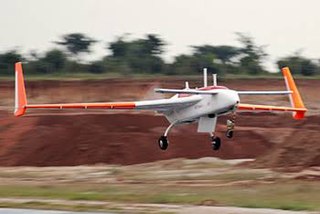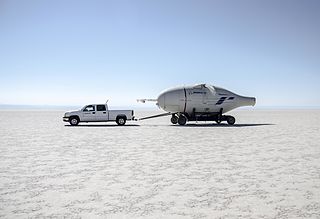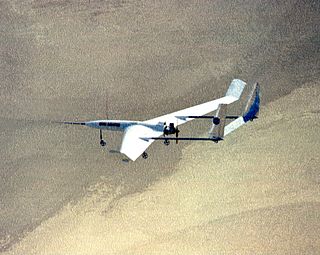
The NASA Mini-Sniffers were a series of unmanned aerial vehicles designed to sample the air at high altitude to support various scientific studies. [1]

The NASA Mini-Sniffers were a series of unmanned aerial vehicles designed to sample the air at high altitude to support various scientific studies. [1]
In the early 1970s, NASA engineer Dale Reed was investigating methods for sampling the atmosphere at very high altitudes, up to 21 kilometers (70,000 feet). NASA's studies into supersonic transport jets had led to questions about their possible impact on the upper atmosphere, and Reed designed a series of "Mini-Sniffer" drones to take air samples at high altitudes. NASA also considered them for planetary atmospheric sampling flights over Mars. [2] Three Mini-Sniffers were built by NASA Dryden Flight Research Center and were flown from 1975 through 1982.
The initial "Mini-Sniffer I" had a wingspan of 5.5 meters (18 feet), tailfins on the wingtips, and canards on the nose. It used a gasoline-powered piston engine and performed a dozen low-altitude flights to validate the design.

The Mini-Sniffer I was then modified into the "Mini-Sniffer II" by removing the canards and the wingtip tailfins, then adding tail booms and extending the wings, giving it a wingspan of 6.7 meters (22 feet). It was still powered by a gasoline engine, and made 21 flights to a maximum altitude of 6,100 meters (20,000 feet).
To get to much higher altitudes, Reed planned to use an unusual engine that burned hydrazine. A normal internal combustion engine burns gasoline with air to generate power, but at 21 kilometers the air is too thin to keep it running. Instead of gasoline, Reed planned to use hydrazine, or N2H4, which breaks down spontaneously when run across a catalyst, generating heat to produce steam to drive the engine. Hydrazine is a corrosive, toxic, and unstable propellant, but its ability to "burn" without oxygen makes it useful for spacecraft thrusters and for such high-altitude engine applications.
"Mini-Sniffer III" was a new build aircraft, similar to Mini-Sniffer II but with a longer fuselage and the hydrazine engine. It was designed to carry an 11.3 kilogram (25 pound) payload to 70,000 feet (21,000 m) or higher. However, the Mini-Sniffer III only made a single flight to 6,100 meters (20,000 feet), and was not flown again because fuel leaks made it hazardous to handle. NASA lost interest in the idea, and the concept of a high-altitude UAV was abandoned until later when the NASA ERAST Program resurrected the idea.

The NASA Pathfinder and NASA Pathfinder Plus were the first two aircraft developed as part of an evolutionary series of solar- and fuel-cell-system-powered unmanned aerial vehicles. AeroVironment, Inc. developed the vehicles under NASA's Environmental Research Aircraft and Sensor Technology (ERAST) program. They were built to develop the technologies that would allow long-term, high-altitude aircraft to serve as atmospheric satellites, to perform atmospheric research tasks as well as serve as communications platforms. They were developed further into the NASA Centurion and NASA Helios aircraft.

The Scaled Composites Model 281 Proteus is a tandem-wing high-altitude long endurance aircraft designed by Burt Rutan to investigate the use of aircraft as high altitude telecommunications relays. The Proteus is a multi-mission vehicle able to carry various payloads on a ventral pylon. The Proteus has an extremely efficient design, and can orbit a point at over 19,800 m for more than 18 hours. It is currently owned by Northrop Grumman.

The AAI Aerosonde is a small unmanned aerial vehicle (UAV) designed to collect weather data, including temperature, atmospheric pressure, humidity, and wind measurements over oceans and remote areas. The Aerosonde was developed by Insitu, and is now manufactured by Aerosonde Ltd, which is a strategic business of AAI Corporation. The Aerosonde is powered by a modified Enya R120 model aircraft engine, and carries on board a small computer, meteorological instruments, and a GPS receiver for navigation. It is also used by the United States Armed Forces for intelligence, surveillance and reconnaissance (ISR).

AeroVironment, Inc. is an American defense contractor headquartered in Arlington, Virginia, that designs and manufactures unmanned aerial vehicles (UAVs). Dr. Paul B. MacCready Jr., a designer of human-powered aircraft, founded the company in 1971. The company is best known for its lightweight human-powered and solar-powered vehicles. The company is the US military's top supplier of small drones — notably the Raven, Switchblade, Wasp and Puma models.

UAVs include both autonomous drones and remotely piloted vehicles (RPVs). A UAV is capable of controlled, sustained level flight and is powered by a jet, reciprocating, or electric engine. In the twenty first century technology reached a point of sophistication that the UAV is now being given a greatly expanded role in many areas of aviation.

A miniature UAV, small UAV (SUAV), or drone is an unmanned aerial vehicle small enough to be man-portable. Smallest UAVs are called micro air vehicle.

The Northrop Grumman Switchblade was a proposed variable sweep oblique wing unmanned aerial vehicle studied by Northrop Grumman for the United States.

The Environmental Research Aircraft and Sensor Technology, or ERAST program was a NASA program to develop cost-effective, slow-flying unmanned aerial vehicles (UAVs) that can perform long-duration science missions at altitudes above 60,000 ft (18,000 m). The project included a number of technology development programs conducted by the joint NASA-industry ERAST Alliance. The project was formally terminated in 2003.

The BAI Aerosystems (BAIA) BQM-147 Dragon unmanned aerial vehicle is a tactical battlefield UAV operated by the US Marine Corps.

The General Atomics Altus is an unmanned aerial vehicle, designed for scientific research, built by General Atomics Aeronautical Systems (GA-ASI).

The DRDO Rustom is a Medium Altitude Long Endurance unmanned air vehicle (UAV) being developed by Defence Research and Development Organisation for the three services, Indian Army, Indian Navy and the Indian Air Force of the Indian Armed Forces. Rustom is derived from the NAL's LCRA developed by a team under the leadership of late Prof Rustom Damania in the 1980s. The UAV will have structural changes and a new engine. Rustom will replace/supplement the Heron UAVs in service with the Indian armed forces.

Atmospheric satellite or pseudo-satellite is a marketing term for an aircraft that operates in the atmosphere at high altitudes for extended periods of time, in order to provide services conventionally provided by an artificial satellite orbiting in space.

The Helios Prototype was the fourth and final aircraft developed as part of an evolutionary series of solar- and fuel-cell-system-powered unmanned aerial vehicles. AeroVironment, Inc. developed the vehicles under NASA's Environmental Research Aircraft and Sensor Technology (ERAST) program. They were built to develop the technologies that would allow long-term, high-altitude aircraft to serve as atmospheric satellites, to perform atmospheric research tasks as well as serve as communications platforms. It was developed from the NASA Pathfinder and NASA Centurion aircraft.

Aurora Flight Sciences is an American aviation and aeronautics research subsidiary of Boeing which primarily specializes in the design and construction of special-purpose Unmanned aerial vehicles. Aurora has been established for 20+ years and their headquarters is at the Manassas Regional Airport in Manassas, Virginia.

AeroVironment, Inc. acquired Arcturus UAV on February 22, 2021.

The Boeing Phantom Eye was a high altitude, long endurance (HALE) liquid hydrogen-powered unmanned aerial vehicle developed by Boeing Phantom Works. The aircraft was Boeing's proposal to meet the demand from the US military for unmanned drones designed to provide advanced intelligence and reconnaissance work, driven by the combat conditions in Afghanistan in particular. In August 2016, the Phantom Eye demonstrator was disassembled for display at the Air Force Flight Test Museum.

The NASA Centurion was the third aircraft developed as part of an evolutionary series of solar- and fuel-cell-system-powered unmanned aerial vehicles. AeroVironment, Inc. developed the vehicles under NASA's Environmental Research Aircraft and Sensor Technology (ERAST) program. They were built to develop the technologies that would allow long-term, high-altitude aircraft to serve as atmospheric satellites, to perform atmospheric research tasks as well as serve as communications platforms. It was developed from the NASA Pathfinder Plus aircraft and was developed into the NASA Helios.

A Mars aircraft is a vehicle capable of sustaining powered flight in the atmosphere of Mars. So far, the Mars helicopter Ingenuity is the only object to ever fly on Mars, completing 28 successful flights covering 6.98 km (4.34 mi) in 54 minutes 16 seconds of flight time. It made the first powered flight on 19 April 2021, taking off from the surface. Previously, the experimental aircraft, NASA Mini-Sniffer, was considered for possible missions to fly in and study Mars' atmosphere, but that idea was abandoned. Aircraft may provide on site measurements of the atmosphere of Mars, as well as additional observations over extended areas. A long-term goal is to develop piloted Mars aircraft.
The ASN UAV are a series of Chinese UAVs developed by Xi'an Aisheng Technology Group Co., Ltd (西安爱生技术集团公司)ASN Technology Group Co., Ltd (西安爱生技术集团公司), also known as Northwestern Polytechnical University UAV Research Institute or 365th Institute, established in 1984.

An unmanned surveillance and reconnaissance aerial vehicle, is an unarmed military UAV that is used for intelligence, surveillance, target acquisition, and reconnaissance (ISTAR). Unlike unmanned combat aerial vehicle (UCAV), this type of system is not designed to carry aircraft ordnance such as missiles, ATGMs, or bombs for drone strikes. The main purpose is to provide battlefield intelligence. Small sized short-range man-portable unmanned aerial vehicles are called miniature UAV also used for battlefield intelligence.
This article contains material that originally came from the web article "Unmanned Aerial Vehicles" by Greg Goebel, which exists in the Public Domain.